
Countries
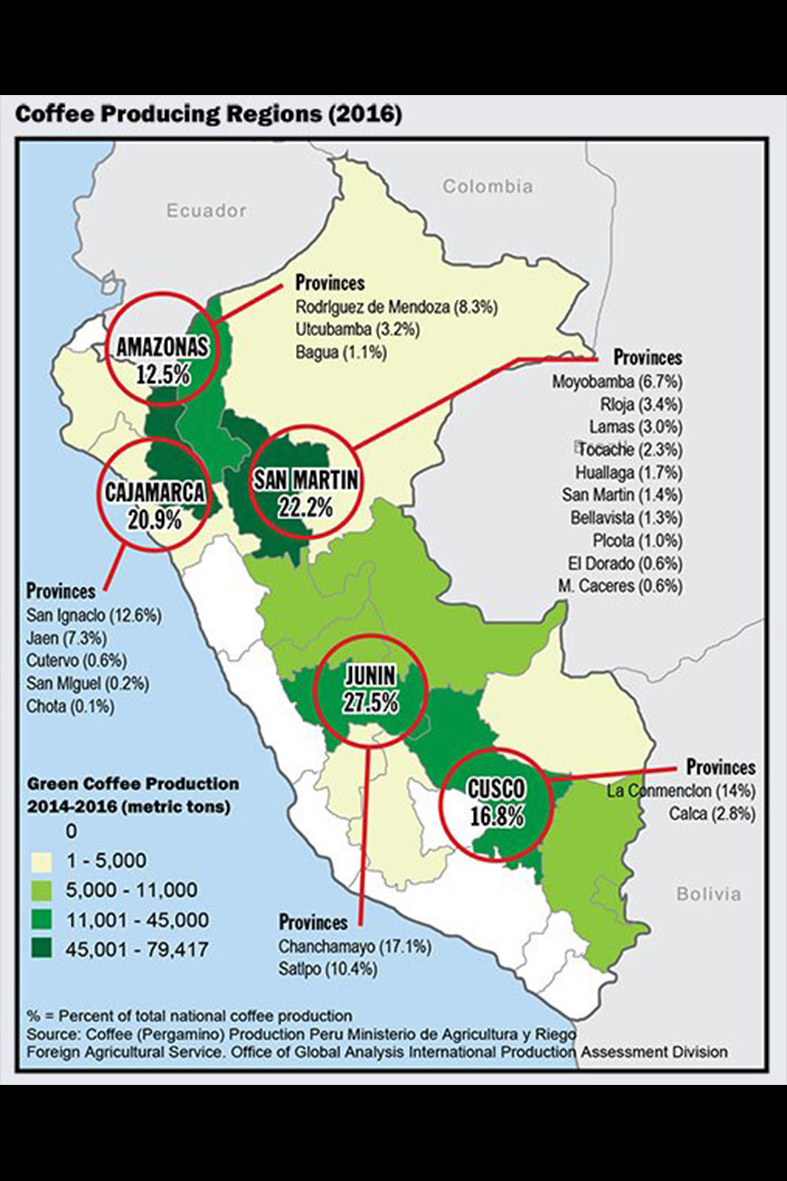
PERU
Peru has a favorable climate for coffee growing conditions and for the production of Specialty Coffee because it has varied habitats with favorable climate and micro-climates for its cultivation.
The coffee production areas in Peru are located above 1,000 meters above sea level with some areas of production as the Santa Teresa Valley in Cusco coming up to an incredible 2100 of altitude above sea level. Regions as Chanchamayo in Junin, Jaen in Amazonas, Sandia in Puno and Quillabamba in Cusco are among the most traditional coffee production areas in Peru.The varieties offered are Typica, Caturra, Bourbón and Pache, with cup characteristics of good flavor, acidity, body and aroma. In 1997 the Peruvian specialty coffee venture into the international market and the 2.000,130 quintals of production exceeded 60% of which correspond to organic coffee as reported by the National Coffee Board.
Peru actively participates in the world organic coffee market. It is one of the main producers along with Mexico and Papua New Guinea. Peru exports 10% of organic coffee worldwide
VARIETY OF COFFEE IN PERU
The coffee is developed relatively easily from 1100 to 2200 meters above sea level in almost all geographic regions of Peru. However, 75% of coffee is about 1350 meters.
The variety of combinations of climates, soils, rainfall and sunlight is a scenario for the cultivation of productive coffee. The coffees of Peru are Coffea arabica with different profiles of flavor, aroma and acidity. The varieties grown are: Typical (70%), Caturra (20%) and others (10%), 90% of Peru's coffee grows in the shade, mainly pulses, at an average density of 2,000 plants per hectare.
In keeping with current trends, some groups of Peruvian farmers and workers have specialized in organic and other specialty coffees and processing, known for their distinctive profile and features as its cup quality, acidity and balanced flavor that fits very well to the microclimates strict temperature and altitude (1400 - 1800 m).
PERU COFFEE EXPORT
In 2019 Peru has export a total of 232,829 ton. Is the word’s 9th large coffee producer and among the 5 first world organic coffee producers.
Traditional markets to where Peru exports coffee to are the US, Germany, Belgium, Sweden and Canada. Some emerging markets where Peru is begging its exportation are China, India, Malasia and some countries in the middle east and east Europe.
The coffee production areas in Peru are located above 1,000 meters above sea level with some areas of production as the Santa Teresa Valley in Cusco coming up to an incredible 2100 of altitude above sea level. Regions as Chanchamayo in Junin, Jaen in Amazonas, Sandia in Puno and Quillabamba in Cusco are among the most traditional coffee production areas in Peru.The varieties offered are Typica, Caturra, Bourbón and Pache, with cup characteristics of good flavor, acidity, body and aroma. In 1997 the Peruvian specialty coffee venture into the international market and the 2.000,130 quintals of production exceeded 60% of which correspond to organic coffee as reported by the National Coffee Board.
Peru actively participates in the world organic coffee market. It is one of the main producers along with Mexico and Papua New Guinea. Peru exports 10% of organic coffee worldwide
VARIETY OF COFFEE IN PERU
The coffee is developed relatively easily from 1100 to 2200 meters above sea level in almost all geographic regions of Peru. However, 75% of coffee is about 1350 meters.
The variety of combinations of climates, soils, rainfall and sunlight is a scenario for the cultivation of productive coffee. The coffees of Peru are Coffea arabica with different profiles of flavor, aroma and acidity. The varieties grown are: Typical (70%), Caturra (20%) and others (10%), 90% of Peru's coffee grows in the shade, mainly pulses, at an average density of 2,000 plants per hectare.
In keeping with current trends, some groups of Peruvian farmers and workers have specialized in organic and other specialty coffees and processing, known for their distinctive profile and features as its cup quality, acidity and balanced flavor that fits very well to the microclimates strict temperature and altitude (1400 - 1800 m).
PERU COFFEE EXPORT
In 2019 Peru has export a total of 232,829 ton. Is the word’s 9th large coffee producer and among the 5 first world organic coffee producers.
Traditional markets to where Peru exports coffee to are the US, Germany, Belgium, Sweden and Canada. Some emerging markets where Peru is begging its exportation are China, India, Malasia and some countries in the middle east and east Europe.
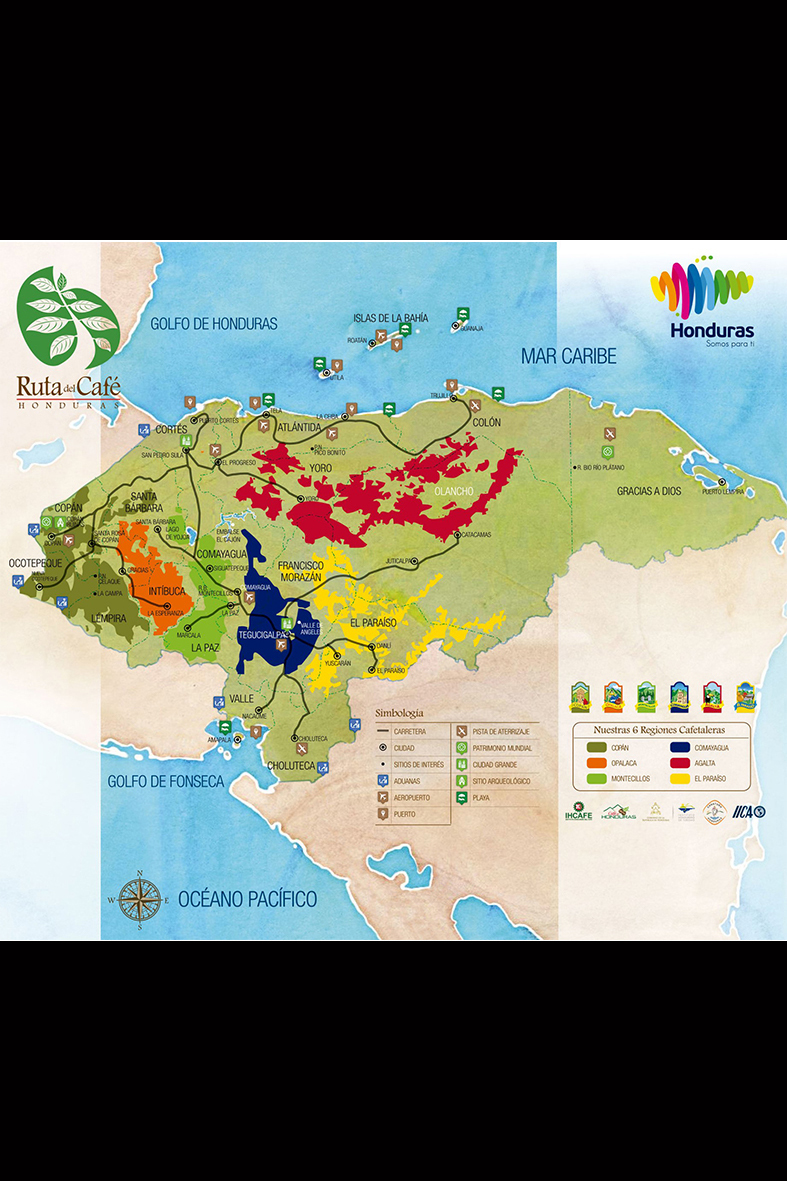
HONDURAS
Coffee has historically been one of Honduras’ leading exports (alongside bananas), and since the mid-2,000s total annual production has grown in leaps and bounds. During the 2009/10 crop year, Honduras produced approximately 3.6 million bags of Arabica coffee (already a big increase over 1999/2000). By 2014/2015, the country had become Central America’s top grower (and number 7 in the world), with a yield of over 5 million bags (all Arabica varietals). With the highest production per capita in the world and various business drivers keeping the industry growing, experts agree that it wouldn’t be surprising for the country to reach 8 million bags in the foreseeable future. All in all, the story is clear: Honduras is a big coffee producing country with a lot of untapped potential for specialty lots and micro-lots.
Today, more than 100,000 families across Honduras are involved in coffee production. 95% of these are small-scale farmers and 70% farm on fewer than 2 hectares (representing some 30% of the country’s total production). The vast majority of farmers (95% or more) rely on family labour (including their own children) for all aspects of agricultural and harvest labour.
In addition to internal and external promotion, Hondura’s IHCAFE (Instituto hondureño del café) offers technical assistance and training to farmers, helps with establishing nurseries and greenhouses, has established innovative pest management and early warning systems. In 2004 it helped to set up a national cupping school, which provides comprehensive training for cuppers and gives young people the opportunity to build a career in coffee quality control.
Honduras has been divided into six well-defined regions. Each region has its own IHCAFE-sponsored cupping lab, which offers farmers a free cupping service. These six main regions are in turn split into various micro regions, demarcated by geography and cup profiles.
Copán (north-west, bordering Guatemala and El Salvador)
1,000 - 1,500 metres above sea level
Harvest Season: November - March
Varieties: Bourbon, Caturra, Catuai
Marcala-Montecillos (south-west)
1,200 - 1,600 metres above sea level
Harvest Season: December – April
Varieties: Bourbon, Catuai, Caturra, Pacas
Opalca (north-west)
1,100 – 1,500 metres above sea level
Harvest Season: November – February
Varieties: Bourbon, Catuai, Typica
Agalta Tropical (north and east)
1,300 - 1,950 metres above sea level
Harvest Season: December – March
Varieties: Bourbon, Caturra, Typica
Comayagua (centre-west)
1,000 - 1,500 metres above sea level
Harvest Season: December – March
Varieties: Bourbon, Caturra, Typica
El Paraíso (south-east)
950 - 1,950 metres above sea level
Harvest Season: December – March
Varieties: Catuai, Caturra
Today, more than 100,000 families across Honduras are involved in coffee production. 95% of these are small-scale farmers and 70% farm on fewer than 2 hectares (representing some 30% of the country’s total production). The vast majority of farmers (95% or more) rely on family labour (including their own children) for all aspects of agricultural and harvest labour.
In addition to internal and external promotion, Hondura’s IHCAFE (Instituto hondureño del café) offers technical assistance and training to farmers, helps with establishing nurseries and greenhouses, has established innovative pest management and early warning systems. In 2004 it helped to set up a national cupping school, which provides comprehensive training for cuppers and gives young people the opportunity to build a career in coffee quality control.
Honduras has been divided into six well-defined regions. Each region has its own IHCAFE-sponsored cupping lab, which offers farmers a free cupping service. These six main regions are in turn split into various micro regions, demarcated by geography and cup profiles.
Copán (north-west, bordering Guatemala and El Salvador)
1,000 - 1,500 metres above sea level
Harvest Season: November - March
Varieties: Bourbon, Caturra, Catuai
Marcala-Montecillos (south-west)
1,200 - 1,600 metres above sea level
Harvest Season: December – April
Varieties: Bourbon, Catuai, Caturra, Pacas
Opalca (north-west)
1,100 – 1,500 metres above sea level
Harvest Season: November – February
Varieties: Bourbon, Catuai, Typica
Agalta Tropical (north and east)
1,300 - 1,950 metres above sea level
Harvest Season: December – March
Varieties: Bourbon, Caturra, Typica
Comayagua (centre-west)
1,000 - 1,500 metres above sea level
Harvest Season: December – March
Varieties: Bourbon, Caturra, Typica
El Paraíso (south-east)
950 - 1,950 metres above sea level
Harvest Season: December – March
Varieties: Catuai, Caturra
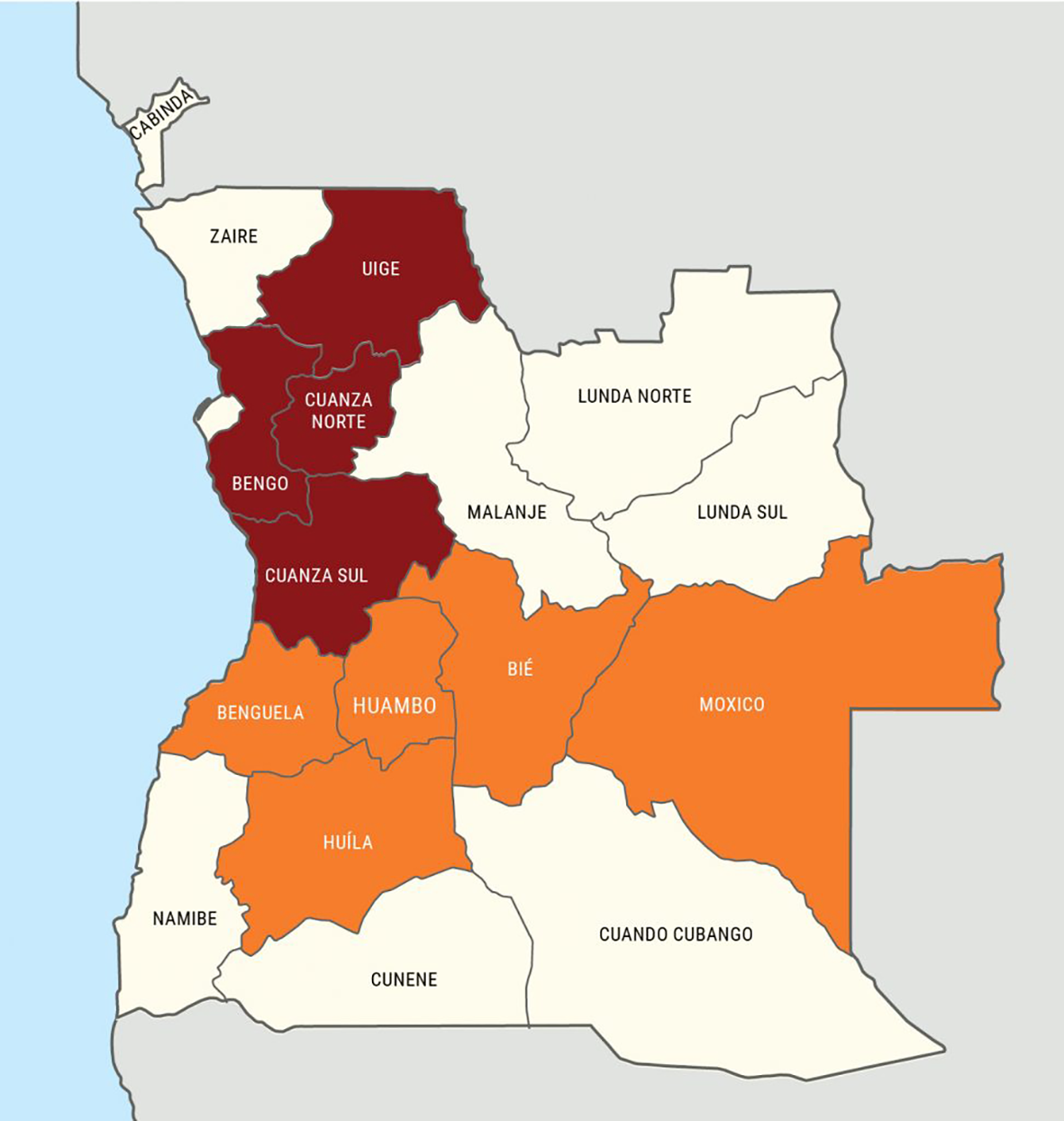
ANGOLA
SOUTHERN COFFEE COMÉRCIO
Southern Coffee Comércio is a modern green coffee trading company in Angola and a sister company of our senior company Pezo Import AB, a renowned company based in Sweden with over 12 years of expertise in coffee trading from Latin America to Europe and China, we are proud to introduce our operations in Angola, specifically focusing on the outsourcing of a quality ensured Angolan coffee.
THE REGIONS WE OUTSOURCE FROM
Angola has several main coffee regions that contribute to the country’s coffee production and export.
Cuanza Sul: Located in the central part of Angola, Cuanza Sul is a region with a long the cultivation of high-quality coffee beans. Cuanza Sul’s coffee beans are recognized for their balanced flavor profile, often exhibiting notes of chocolate, citrus, and floral undertones.
Cuanza Norte: Situated in the northern part of Angola, Cuanza Norte is another notable industry. Although it may not be as widely recognized as other African coffee-producing history of coffee production. The rich volcanic soil and mild climate of this region support
coffee region in the country. The region’s favorable climate and fertile soil contribute to the production of coffee with distinctive flavors. The coffee from Cuanza Norte is often characterized by its fruity and floral notes, with a medium to high acidity level.
Uíge: Located in the northern part of Angola, Uíge is known for its coffee production, with coffee farming being a vital part of the region’s economy. Uíge benefits from the region’s tropical climate and rich volcanic soil, which result in the production of coffee beans with a deep and complex flavor profile. The coffee from Uíge often exhibits notes of chocolate, caramel, and roasted nuts.
ANGOLA COFFEE STANDARDS WE FOLLOW
Angola has established rigorous quality standards for its coffee industry to ensure the production of high-quality beans. The coffee quality standards in Angola encompass factors such as bean size, color, level of defects, moisture content, and taste profile. These
standards help in maintaining consistency and guaranteeing that only the finest beans make it to the market.
Moreover, Angola follows a commercial coffee grade system that classifies the beans based on their shape and screen size. This system includes grades such as (I) Extra, (II) Superior, (III) 1st Quality, (AA+) 2nd Quality AA, (V) 2nd quality BB, (VI) 3d Quality CC and (VII) 3d Quality DD, where Extra being the largest and highest quality beans and DD representing the smallest and lowest quality beans.
By adhering to these quality standards and grade systems, Angola aims to uphold its reputation as a top-quality coffee producer in the global market.
Southern Coffee Comércio is a modern green coffee trading company in Angola and a sister company of our senior company Pezo Import AB, a renowned company based in Sweden with over 12 years of expertise in coffee trading from Latin America to Europe and China, we are proud to introduce our operations in Angola, specifically focusing on the outsourcing of a quality ensured Angolan coffee.
THE REGIONS WE OUTSOURCE FROM
Angola has several main coffee regions that contribute to the country’s coffee production and export.
Cuanza Sul: Located in the central part of Angola, Cuanza Sul is a region with a long the cultivation of high-quality coffee beans. Cuanza Sul’s coffee beans are recognized for their balanced flavor profile, often exhibiting notes of chocolate, citrus, and floral undertones.
Cuanza Norte: Situated in the northern part of Angola, Cuanza Norte is another notable industry. Although it may not be as widely recognized as other African coffee-producing history of coffee production. The rich volcanic soil and mild climate of this region support
coffee region in the country. The region’s favorable climate and fertile soil contribute to the production of coffee with distinctive flavors. The coffee from Cuanza Norte is often characterized by its fruity and floral notes, with a medium to high acidity level.
Uíge: Located in the northern part of Angola, Uíge is known for its coffee production, with coffee farming being a vital part of the region’s economy. Uíge benefits from the region’s tropical climate and rich volcanic soil, which result in the production of coffee beans with a deep and complex flavor profile. The coffee from Uíge often exhibits notes of chocolate, caramel, and roasted nuts.
ANGOLA COFFEE STANDARDS WE FOLLOW
Angola has established rigorous quality standards for its coffee industry to ensure the production of high-quality beans. The coffee quality standards in Angola encompass factors such as bean size, color, level of defects, moisture content, and taste profile. These
standards help in maintaining consistency and guaranteeing that only the finest beans make it to the market.
Moreover, Angola follows a commercial coffee grade system that classifies the beans based on their shape and screen size. This system includes grades such as (I) Extra, (II) Superior, (III) 1st Quality, (AA+) 2nd Quality AA, (V) 2nd quality BB, (VI) 3d Quality CC and (VII) 3d Quality DD, where Extra being the largest and highest quality beans and DD representing the smallest and lowest quality beans.
By adhering to these quality standards and grade systems, Angola aims to uphold its reputation as a top-quality coffee producer in the global market.
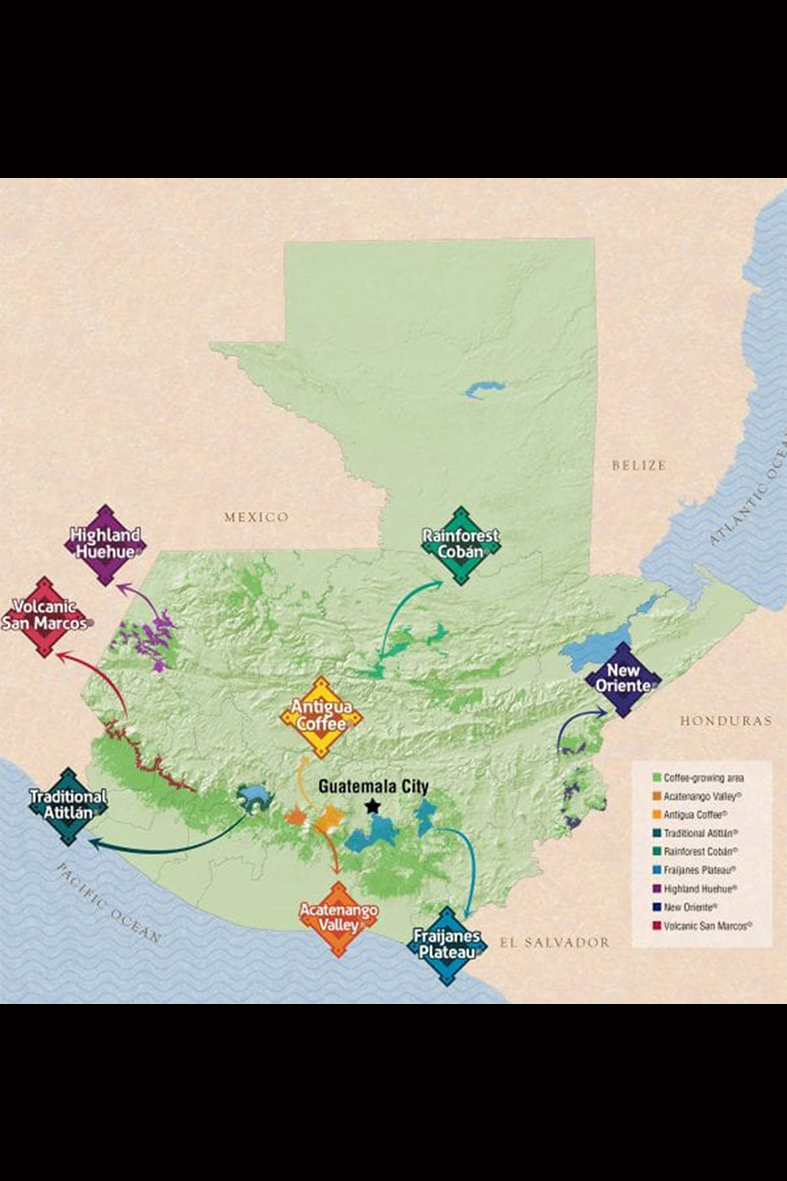
GUATEMALA
Guatemala is a country known for its production of high-quality coffee. Guatemalan coffee is regarded as one of the best types of coffee in the world because it grows in mountainous areas where it develops a more intense, tart flavor, depending of course on the climatic conditions under which it was grown.
Guatemalan coffee production is slowly recovering from the rust outbreak of 2012, and planted area is revised up 9 percent as new rust tolerant varieties are planted. Production for May 2017 closed at 3.3 million bags, down six percent from the previous estimate. May 2018 coffee production is estimated at 3.3 million bags, down two percent from the previous forecast and is forecast to maintain stable in May 2019. The United States, Japan, and Canada continue to be the top export markets.
AREAS OF COFFEE PRODUCTION & PROFILE IN GUATEMALA
Botanical species: Arabica and Robusta, whereof genetical varieties are Bourbon, Caturra, Geisha, Catuai, Catimor, Pacamara and Maragotype.
Country-Specific Grading - SHB (Strictly Hard Bean, 1600–1700 masl); FHB (Fancy Hard Bean, 1500–1600 masl); HB (Hard Bean, 1350–1500 masl)
Common Varieties - Bourbon, Caturra, Catuai, Typica, Maragogype, Pache
Processing Method/s – Washed. Honey. Natural and Anaerobic.
Country-Specific Grading - SHB (Strictly Hard Bean); FHB (Fancy Hard Bean); HB (Hard Bean)
Bag Size - 30 kg
Harvest Period - September–April
Typical Arrival - June
Growing Regions:
ANTIGUA has farms mostly between 1300–1600 meters. The volcanic soil helps lock in moisture, as the region is sunnier and the coffees are sweet, smooth, and good for blending or as mild, lower-acid single-origin offerings.
ATITLAN has a very rich soil composition thanks to the volcanoes around Lake Atitlan. The windy and humid climate contribute to the nutty, dark chocolate characteristics that are balanced by a lemony citrus aftertaste and some florals.
HUEHUETENANGO is the most famous region, and has the highest altitudes in the country, as high as 2,000 meters. Coffee from this region tend to be the most fruit-forward and can price to be the most complete coffee that Guatemala has to offer.
COBAN has more gentle coffees in flavor, with an otherwise full body, and rounded profile. Distinctive coffee for Its soft acidity and light floral aromas. Coffees from Coban and Huehuetenango tend to be from micro & smaller farms.
NUEVO ORIENTE is a small region in the south-east part of the country produces a full-bodied coffee with loads of fruitful-floral balance. The climate in this region is cloudy and rainy than the rest of the country.
Guatemalan coffee production is slowly recovering from the rust outbreak of 2012, and planted area is revised up 9 percent as new rust tolerant varieties are planted. Production for May 2017 closed at 3.3 million bags, down six percent from the previous estimate. May 2018 coffee production is estimated at 3.3 million bags, down two percent from the previous forecast and is forecast to maintain stable in May 2019. The United States, Japan, and Canada continue to be the top export markets.
AREAS OF COFFEE PRODUCTION & PROFILE IN GUATEMALA
Botanical species: Arabica and Robusta, whereof genetical varieties are Bourbon, Caturra, Geisha, Catuai, Catimor, Pacamara and Maragotype.
Country-Specific Grading - SHB (Strictly Hard Bean, 1600–1700 masl); FHB (Fancy Hard Bean, 1500–1600 masl); HB (Hard Bean, 1350–1500 masl)
Common Varieties - Bourbon, Caturra, Catuai, Typica, Maragogype, Pache
Processing Method/s – Washed. Honey. Natural and Anaerobic.
Country-Specific Grading - SHB (Strictly Hard Bean); FHB (Fancy Hard Bean); HB (Hard Bean)
Bag Size - 30 kg
Harvest Period - September–April
Typical Arrival - June
Growing Regions:
ANTIGUA has farms mostly between 1300–1600 meters. The volcanic soil helps lock in moisture, as the region is sunnier and the coffees are sweet, smooth, and good for blending or as mild, lower-acid single-origin offerings.
ATITLAN has a very rich soil composition thanks to the volcanoes around Lake Atitlan. The windy and humid climate contribute to the nutty, dark chocolate characteristics that are balanced by a lemony citrus aftertaste and some florals.
HUEHUETENANGO is the most famous region, and has the highest altitudes in the country, as high as 2,000 meters. Coffee from this region tend to be the most fruit-forward and can price to be the most complete coffee that Guatemala has to offer.
COBAN has more gentle coffees in flavor, with an otherwise full body, and rounded profile. Distinctive coffee for Its soft acidity and light floral aromas. Coffees from Coban and Huehuetenango tend to be from micro & smaller farms.
NUEVO ORIENTE is a small region in the south-east part of the country produces a full-bodied coffee with loads of fruitful-floral balance. The climate in this region is cloudy and rainy than the rest of the country.
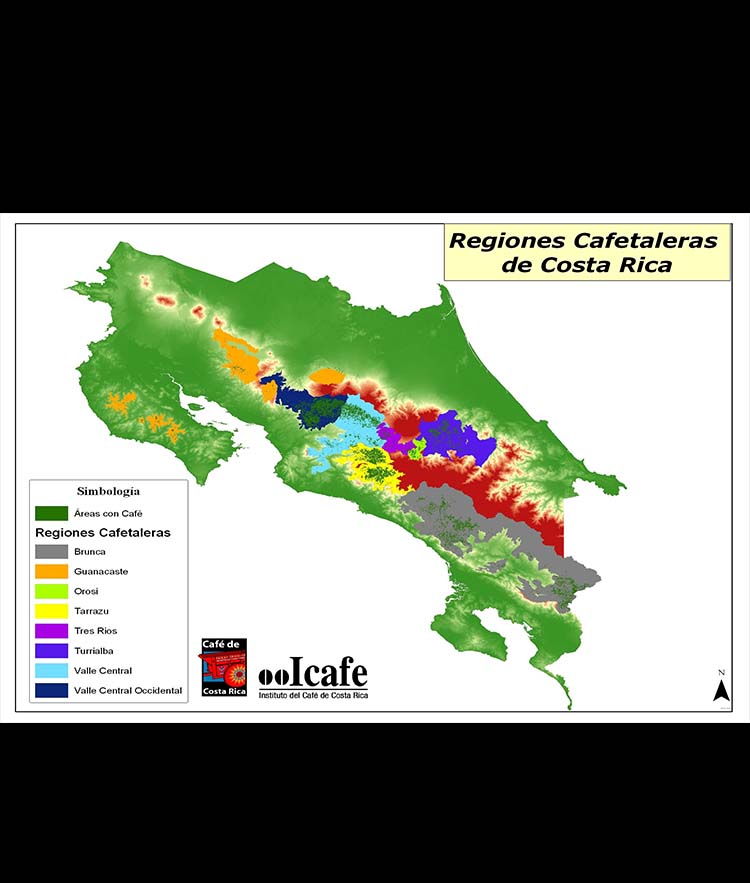
COSTA RICA
The Arabica coffee plant was first introduced to Costa Rica near the end of the 18th century and since it has grown in country’s Central Valley, an ideal place for planting and growing conditions. The country produces consistently high-quality Arabica beans with compelling flavours of chocolate and ripe fruit. In fact, some say Costa Rican coffees have the best flavor profile in the world. Today Costa Rica is among the 15th largest coffee growing countries in the world (with the world happies coffee farmers – so they say
Costa Rican coffees are generally believed to have some of the best coffee flavour profiles in central America. Coffee grows in high altitudes, and it generally has softly acidity, and it’s defining sensorial tones include a brown sugar sweetness, remarkable citrusy notes, and red fruity flavours.
Coffee beans are carefully selected and picked by hand, this is a practice that involves many generations in constantly developing technic that leads to best brews by allowing beans to fully mature and not rushing any beans developing process.
Most coffee in Costa Rica comes from the caturra coffee varietal which is characterized for been a bright, density and full-bodied coffee. Among other varieties that can be found in Costa Rica are Mondo Novo and Catuai. Recently has been noticed a lot of new planting of Gesha variety across the country.
Costa Rican coffees are generally believed to have some of the best coffee flavour profiles in central America. Coffee grows in high altitudes, and it generally has softly acidity, and it’s defining sensorial tones include a brown sugar sweetness, remarkable citrusy notes, and red fruity flavours.
Coffee beans are carefully selected and picked by hand, this is a practice that involves many generations in constantly developing technic that leads to best brews by allowing beans to fully mature and not rushing any beans developing process.
Most coffee in Costa Rica comes from the caturra coffee varietal which is characterized for been a bright, density and full-bodied coffee. Among other varieties that can be found in Costa Rica are Mondo Novo and Catuai. Recently has been noticed a lot of new planting of Gesha variety across the country.
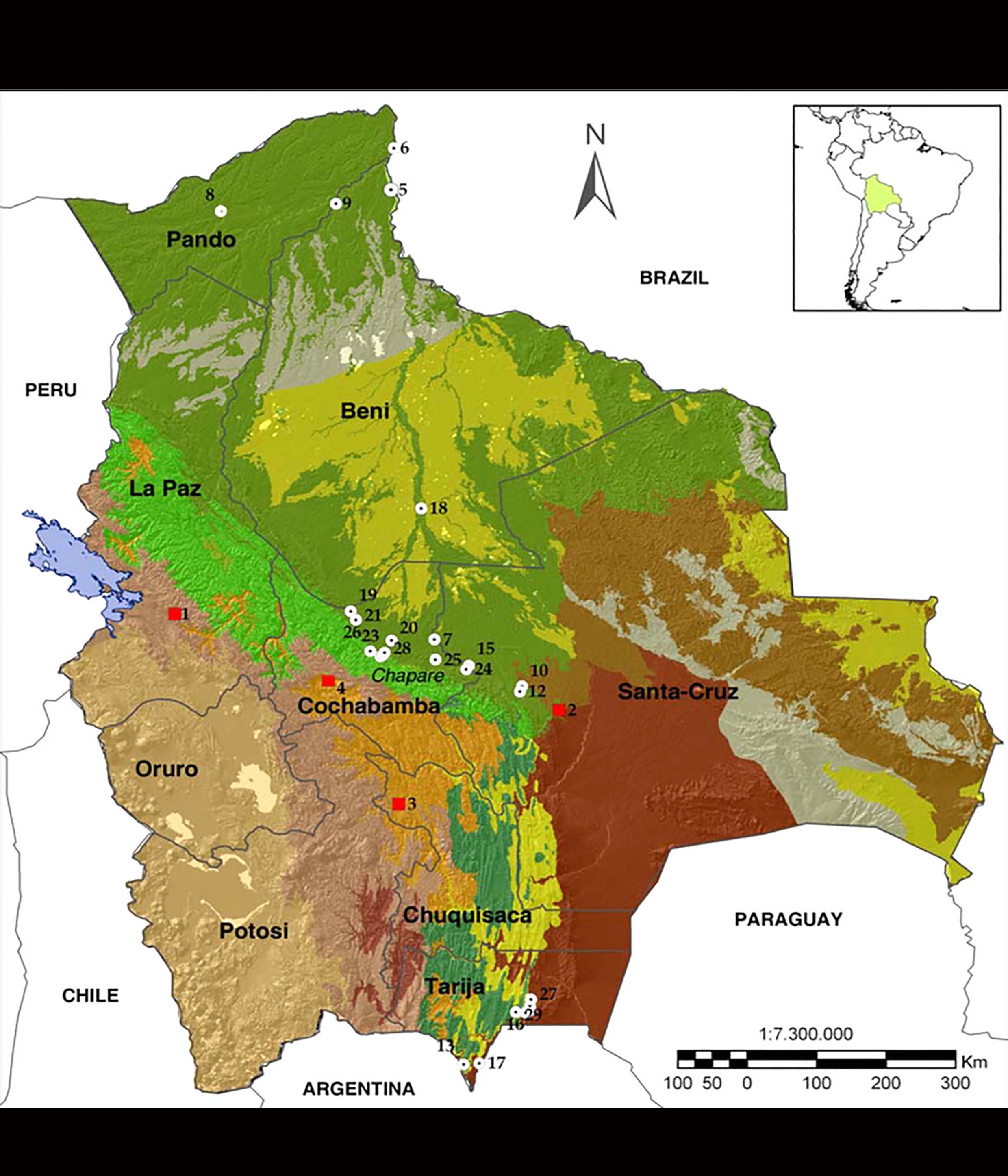
BOLIVIA
Located at the hearth of South America and with excellent regions with impressive high altitudes coffee farms, Bolivia has all the ingredients for becoming the world’s home of excellent coffee. In Bolivia, specialty coffee grows at an altitude of 1600 – 2200 masl. Yungas and the province of Caravani produce 90% of the country’s coffee production and after the 1991 governmental land reform, small coffee farms are now the gross of the country’s majority coffee production.
Bolivia, in comparation with its neighbored countries, does not produce and neither export to much coffee. Bolivian coffees are mainly elegant, delicate, and aromatically sweet, bright with exquisite complexity body. Bolivia has always been a coffee origin with great potential to have unique specialty coffee with unique character. Although, the majority farming been in small scale of coffee production makes of Bolivia a perfect paradise for especial micro lots coffees.
Visiting coffee farms in Bolivia is always a life adventure as the road to the hearth of the country’s coffee production (Yungas) is considered to be the ¨world’s most dangerous road¨ (also known as the death road), which you can travel alone by bus, jeep or simply in a full adrenaline mountain bike adventure.
Bolivia, in comparation with its neighbored countries, does not produce and neither export to much coffee. Bolivian coffees are mainly elegant, delicate, and aromatically sweet, bright with exquisite complexity body. Bolivia has always been a coffee origin with great potential to have unique specialty coffee with unique character. Although, the majority farming been in small scale of coffee production makes of Bolivia a perfect paradise for especial micro lots coffees.
Visiting coffee farms in Bolivia is always a life adventure as the road to the hearth of the country’s coffee production (Yungas) is considered to be the ¨world’s most dangerous road¨ (also known as the death road), which you can travel alone by bus, jeep or simply in a full adrenaline mountain bike adventure.
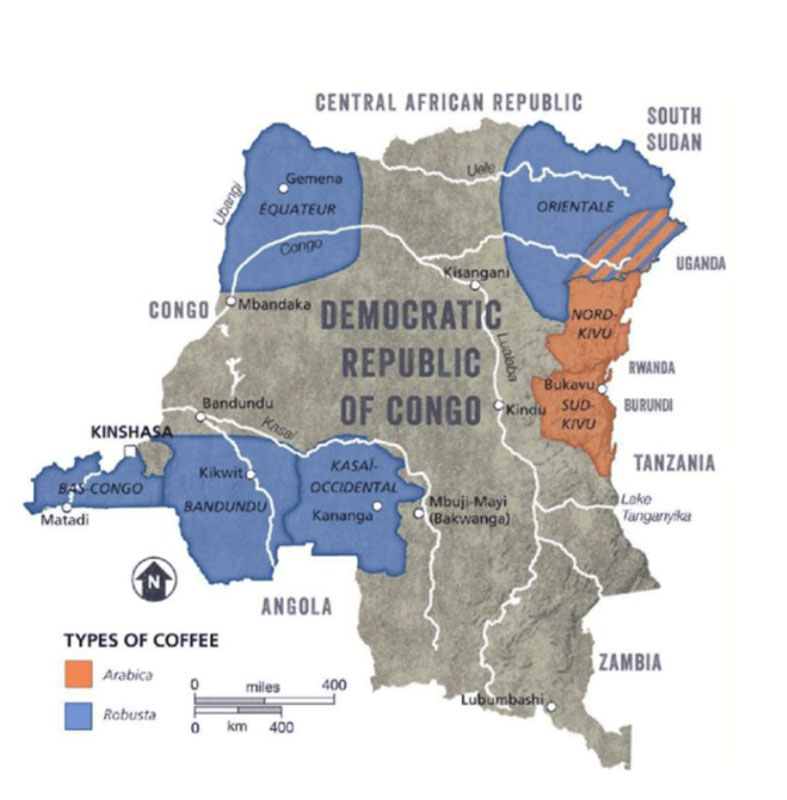
D.R. CONGO
Due to its large territory in the central African region, the Democratic Republic of Congo (DRC) has several large areas of coffee production. In Congo we can find great production of both Arabica and Robusta coffee, although the regions are thousands of km away from each other and the road infrastructure is very remote of just non-existing. Due to its ideal geographic conditions Congo can produce very high-quality Arabica and Robusta. DRC is considered one of new jewels in the specialty coffee world.
History say that coffee come to the DRC around late 19th century from Liberia, and coffee was one of the main farming activities on the Belgian colonialist times. Several specialty and endemics coffees come from the DRC. As for example, only in the DRC we find the small Robusta coffee call Pettit Kwilu, a very small Robusta beans coffee with characteristic flavors. Robusta coffee is mainly natural processed, and the main Arabica variety is the Bourbon variety. Although you can find coffee all year round in the DRC, the main harvest seasons are for Robusta between March – June and for Arabica from October to December.
THE REGIONS WE OUTSOURCE FROM
Kongo central (Lukula) from its crumbling colonial-era buildings, the town of Lukula has several well-organized NGO’s that cooperates, organizes and improves the living standards of coffee producers along the Kongo Central region. The region produces Robusta coffee and its near to one of the mayor export ports in the DRC, the port of Matadi.
Gemena (sub-Ubangi) is a region where predominant Robusta coffee variety is growing. Sub-Ubangi region was recently recognized as region after been part of the Equatorial province in the north-east of the DRC. During the civil war, coffee production in Gemena declined sharply. Today, the coffee production around sub-Ubangi is flourishing again (after private initiatives and governmental programs) and it’s expected to be one of the main Robusta coffee regions in the DRC.
Kivu Region: Kivu is a large region in the eastern part of DRC. It borders with Uganda, Rwanda and surrounds the lake Kivu. The region is divided into three provinces, Nord-Kivu (North Kivu), Sud-Kivu (South Kivu), and Maniema. The whole Kivu region has great potential for stable and quality coffee, unfortunately, there are still some armed groups controlling some areas which make coffee activity harder than it already is in DRC.
However, the infrastructure for the coffee industry in Congo remains a challenge. Nevertheless there is high hope among the coffee farmers, that coffee could be part of their regions development. Both the government and NGOs have been investing heavily in the coffee sector and there is an international growing interest in the country’s potential for high-quality coffee. Congo’s soil, climate and altitude, gives the opportunity of producing truly exceptional coffees that can easely enter to compete with more stablished coffee producer countries around the globe.
History say that coffee come to the DRC around late 19th century from Liberia, and coffee was one of the main farming activities on the Belgian colonialist times. Several specialty and endemics coffees come from the DRC. As for example, only in the DRC we find the small Robusta coffee call Pettit Kwilu, a very small Robusta beans coffee with characteristic flavors. Robusta coffee is mainly natural processed, and the main Arabica variety is the Bourbon variety. Although you can find coffee all year round in the DRC, the main harvest seasons are for Robusta between March – June and for Arabica from October to December.
THE REGIONS WE OUTSOURCE FROM
Kongo central (Lukula) from its crumbling colonial-era buildings, the town of Lukula has several well-organized NGO’s that cooperates, organizes and improves the living standards of coffee producers along the Kongo Central region. The region produces Robusta coffee and its near to one of the mayor export ports in the DRC, the port of Matadi.
Gemena (sub-Ubangi) is a region where predominant Robusta coffee variety is growing. Sub-Ubangi region was recently recognized as region after been part of the Equatorial province in the north-east of the DRC. During the civil war, coffee production in Gemena declined sharply. Today, the coffee production around sub-Ubangi is flourishing again (after private initiatives and governmental programs) and it’s expected to be one of the main Robusta coffee regions in the DRC.
Kivu Region: Kivu is a large region in the eastern part of DRC. It borders with Uganda, Rwanda and surrounds the lake Kivu. The region is divided into three provinces, Nord-Kivu (North Kivu), Sud-Kivu (South Kivu), and Maniema. The whole Kivu region has great potential for stable and quality coffee, unfortunately, there are still some armed groups controlling some areas which make coffee activity harder than it already is in DRC.
However, the infrastructure for the coffee industry in Congo remains a challenge. Nevertheless there is high hope among the coffee farmers, that coffee could be part of their regions development. Both the government and NGOs have been investing heavily in the coffee sector and there is an international growing interest in the country’s potential for high-quality coffee. Congo’s soil, climate and altitude, gives the opportunity of producing truly exceptional coffees that can easely enter to compete with more stablished coffee producer countries around the globe.
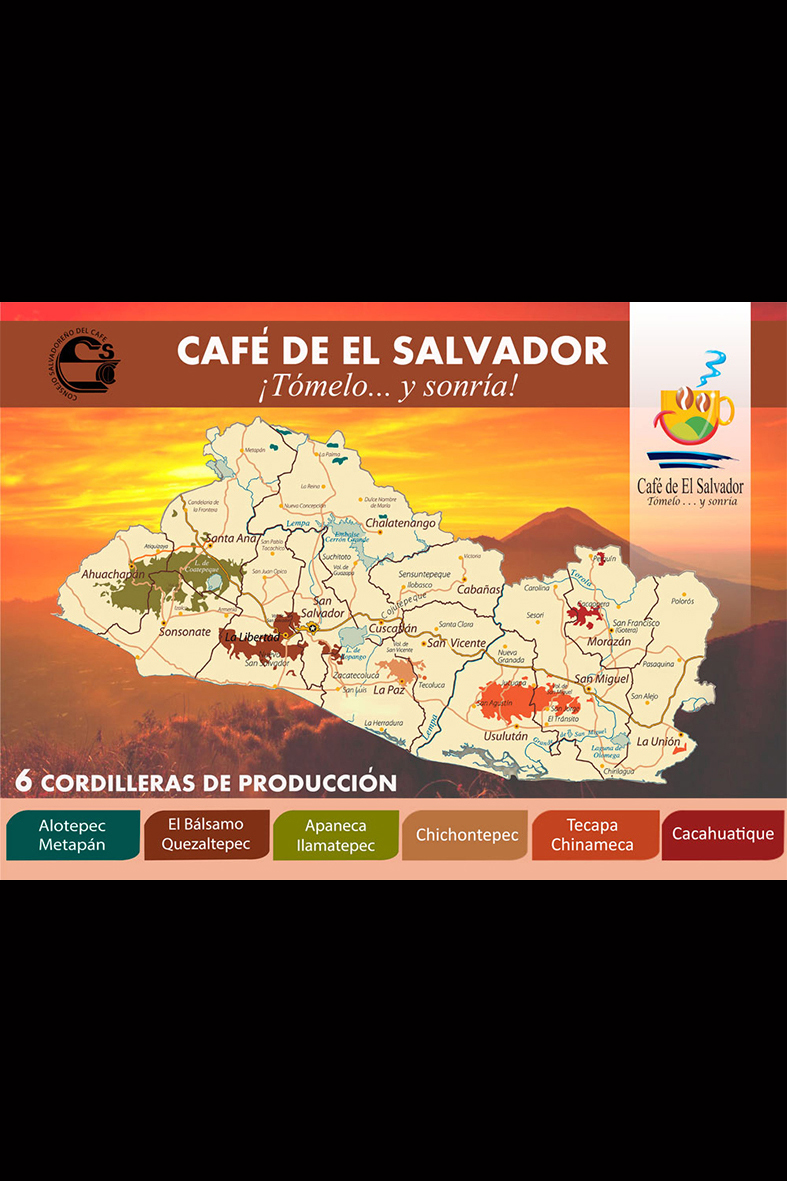
EL SALVADOR
El Salvador is recovering from a civil war, which ironically preserved many of the traditional varieties of arabica like bourbon from replacement with more modern, sun-grown hybrid coffee varieties. Most El Salvadors are soft, ingratiating coffees with relatively subdued acidity, much like many Mexico and Central America coffees grown on ocean-influenced slopes and valleys. Nevertheless, these El Salvador coffees can be fine, if gentle: abundant in fragrancy and seductive aroma. Occasionally an El Salvador coffee appears powerful, deep, and fine acidy body .
Most of El Salvador farms and cooperatives, grow the intriguing hybrid variety pacamara, a tree that produces a large bean that is a cross between the extremely large-beaned maragogipe and a local strain of the caturra variety called paca. From an aficionado point of view, pacamara is a fascinating hybrid because it is superior in cup quality to either of its parent varieties. From a coffee drinker’s point of view, the large bean makes an interesting curiosity and the soft but complex cup gives some sensual support to the conversation-invoking potential of the bean size.
The best grade of El Salvador coffee is Strictly High Grown (SHG). Most El Salvador coffee is grown in various degrees of shade. Here are some of the most significant varieties:
1. Variety Tekisic
Tekisic variety (improved bourbon) comes from the selection process of the traditional Bourbon variety, started in 1949. In 1973, the cultivating of elite plants was established at the Experimental Station (Santa Tecla), it was released as a commercial variety TEKISIC in 1976 for its ideal production characteristics and cup quality. TEKISIC It is made up of the words: TEKITI means work in the Nahuat language, and ISIC, which is the acronym for the Salvadoran Institute for Coffee Research. It is the main cultivated variety of the country with approximately 50% of the total area. The main characteristics are: tall tree, abundant lateral, flexible stem, medium leaves, large red fruit, excellent drink quality, citrus and fruit flavors prevail.
2. Variety Pacas.
It originated from a mutation of the traditional Bourbon, discovered in 1949 in the San Rafael estate, Palo Campana canton (Santa Ana Volcano), Santa Ana department, owned by the Pacas family. At that time the plant caught the attention of coffee growers for its compact morphological appearance and they called it in several ways: Arabian hybrid with San Ramón, Cafeto del Norte and Cafeto del Viento, later it was assigned the name PACAS variety, in honor of family name on whose property the variety was identified.
In the year 1,960, the ISIC (Salvadoran Institute for Coffee Research) began the study of PACAS, with the objective of observing the morphological differences with respect to the cultivars CATURRA ROJO (Brazil) and VILLA SARCHI (Costa Rica), concluding that they are genetically similar. The PACAS variety is distributed in 27% of the country's total. Its main characteristics are: Low bearing, with lateral branches that form an angle of 45 degrees. Abundant foliage, brightly colored. Tolerance to drought, wind and sun problems. The fruit is red in color, of excellent drink quality. It is best adapted to altitudes of 500 to 1,100 meters above sea level.
3. Variety Pacamara.
In 1958 the ISIC began work on the genetic improvement of the coffee tree through the hybridization process, using the Pacas and Maragogipe Rojo varieties as parents.
The procedure of this work done in El Salvador, consisted of individual selection by plant until obtaining mother plants that gave rise to nine lines, which due to their phenotypic appearance, production, yield, fruit size and adaptability, were matters of interest continuing with its evaluation in different coffee areas of the country, until it comes to form a physical mix of the selected lines and thus obtain a new variety called PACAMARA. The successful launch of this one, took place in the early 80s in the fifth generation (F5).
Characteristics
Size: Intermediate to slightly high (in relation to Pacas and Maragogipe).
Fruits of intermediate size, increasing their size at a higher height, of red color, elongated type and with the navel of the bulky fruit. Large grains with a size of 0.90 cm. long, 0.69 cm. width, thickness 0.36 cm.
Organoleptic qualities: Impressive aroma with a note of floral chocolate and honey.
full body.
Excellent acidity, very fine and with brilliance. Sweet chocolate flavor, complex.
Pleasant long aftertaste with a sweet note (honey) and notes of cinnamon.
Attribute of Taste of Jasmine and peach. Coffee with very particular exotic characteristics.
Value added
The coffee of the Pacamara variety, in addition to its physiological structure that brings benefits to the environment, is a product that, due to its high quality, is being quoted more and more in the most demanding markets, providing producers with greater profitability and offering benefits. additional to society, becoming an example of innovation and creativity within the region's coffee sector.
4. Variety Red Catuai.
Es originaria de Brasil y es el resultado del cruce CATURRA AMARILLO por MUNDO NOVO.
Fue introducida al país en la década de los años setenta, pero antes de liberarla, el ISIC inició, un proceso de evaluación y selección, obteniéndose muy buenos resultados en adaptabilidad, rendimiento y calidad de bebida.
Sus características principales son: Planta vigorosa de porte bajo, menos compacta y más alta que la variedad PACAS. Laterales largos y entrenudos cortos, con abundante ramificación y tendencia a la formación de crinolinas (palmillas), con hojas ligeramente redondeadas y brillantes, brotes y hojas de color verde. Alta capacidad productiva, con fruto de color rojo y/o amarillo y de excelente calidad de bebida, incrementando sus cualidades gustativas cuando es cultivado en condiciones de estricta altura. Las condiciones óptimas de altitud para su cultivo inicia desde 600 hasta 1,200 msnm.
It is native from Brazil and is the result of crossing varieties of CATURRA AMARILLO by MUNDO NOVO. It was introduced to El Salvador in the 1970s, but before releasing it, the ISIC (Salvadoran Institute for Coffee Research) began an evaluation and selection process, obtaining very good results in adaptability, performance and drink quality.
Its main characteristics are: Vigorous plant of low bearing, less compact and higher than the PACAS variety. Long laterals and short internodes, with abundant branching, shoots and green leaves. High productive capacity, with red and / or yellow fruit and excellent drink quality, increasing its taste qualities when grown under conditions of strict height. The optimal altitude conditions for cultivation start from 600 to 1,200 masl.
5. Variety Cuzcatleco.
It originates from the cross between the Timor hybrid and the Villa Sarchi coffee variety (T5296), the characteristics are: strong and deep root system, very vigorous shape, conical in shape, long sides and short internodes, dense foliage, large deep green leaves, resistant and early to produce. The fruits are red, resistant to falling due to the effects of rain, large and elongated. The planting altitude range ranges from 600 to 1,200 meters above sea level, with pleasant drink quality.
6. Variety Icatú.
This variety is obtained from the artificial chromosome duplication of the Canephora species and then it was crossed with the Bourbon variety, it was originally called "Arabusta", later this "Arabusta" was retro-crossed with the Mundo Novo variety, giving rise to the ICATÚ. It is a variety that is evaluated in EL Salvador as promising in production, adaptability and pleasant cup quality.
Most of El Salvador farms and cooperatives, grow the intriguing hybrid variety pacamara, a tree that produces a large bean that is a cross between the extremely large-beaned maragogipe and a local strain of the caturra variety called paca. From an aficionado point of view, pacamara is a fascinating hybrid because it is superior in cup quality to either of its parent varieties. From a coffee drinker’s point of view, the large bean makes an interesting curiosity and the soft but complex cup gives some sensual support to the conversation-invoking potential of the bean size.
The best grade of El Salvador coffee is Strictly High Grown (SHG). Most El Salvador coffee is grown in various degrees of shade. Here are some of the most significant varieties:
1. Variety Tekisic
Tekisic variety (improved bourbon) comes from the selection process of the traditional Bourbon variety, started in 1949. In 1973, the cultivating of elite plants was established at the Experimental Station (Santa Tecla), it was released as a commercial variety TEKISIC in 1976 for its ideal production characteristics and cup quality. TEKISIC It is made up of the words: TEKITI means work in the Nahuat language, and ISIC, which is the acronym for the Salvadoran Institute for Coffee Research. It is the main cultivated variety of the country with approximately 50% of the total area. The main characteristics are: tall tree, abundant lateral, flexible stem, medium leaves, large red fruit, excellent drink quality, citrus and fruit flavors prevail.
2. Variety Pacas.
It originated from a mutation of the traditional Bourbon, discovered in 1949 in the San Rafael estate, Palo Campana canton (Santa Ana Volcano), Santa Ana department, owned by the Pacas family. At that time the plant caught the attention of coffee growers for its compact morphological appearance and they called it in several ways: Arabian hybrid with San Ramón, Cafeto del Norte and Cafeto del Viento, later it was assigned the name PACAS variety, in honor of family name on whose property the variety was identified.
In the year 1,960, the ISIC (Salvadoran Institute for Coffee Research) began the study of PACAS, with the objective of observing the morphological differences with respect to the cultivars CATURRA ROJO (Brazil) and VILLA SARCHI (Costa Rica), concluding that they are genetically similar. The PACAS variety is distributed in 27% of the country's total. Its main characteristics are: Low bearing, with lateral branches that form an angle of 45 degrees. Abundant foliage, brightly colored. Tolerance to drought, wind and sun problems. The fruit is red in color, of excellent drink quality. It is best adapted to altitudes of 500 to 1,100 meters above sea level.
3. Variety Pacamara.
In 1958 the ISIC began work on the genetic improvement of the coffee tree through the hybridization process, using the Pacas and Maragogipe Rojo varieties as parents.
The procedure of this work done in El Salvador, consisted of individual selection by plant until obtaining mother plants that gave rise to nine lines, which due to their phenotypic appearance, production, yield, fruit size and adaptability, were matters of interest continuing with its evaluation in different coffee areas of the country, until it comes to form a physical mix of the selected lines and thus obtain a new variety called PACAMARA. The successful launch of this one, took place in the early 80s in the fifth generation (F5).
Characteristics
Size: Intermediate to slightly high (in relation to Pacas and Maragogipe).
Fruits of intermediate size, increasing their size at a higher height, of red color, elongated type and with the navel of the bulky fruit. Large grains with a size of 0.90 cm. long, 0.69 cm. width, thickness 0.36 cm.
Organoleptic qualities: Impressive aroma with a note of floral chocolate and honey.
full body.
Excellent acidity, very fine and with brilliance. Sweet chocolate flavor, complex.
Pleasant long aftertaste with a sweet note (honey) and notes of cinnamon.
Attribute of Taste of Jasmine and peach. Coffee with very particular exotic characteristics.
Value added
The coffee of the Pacamara variety, in addition to its physiological structure that brings benefits to the environment, is a product that, due to its high quality, is being quoted more and more in the most demanding markets, providing producers with greater profitability and offering benefits. additional to society, becoming an example of innovation and creativity within the region's coffee sector.
4. Variety Red Catuai.
Es originaria de Brasil y es el resultado del cruce CATURRA AMARILLO por MUNDO NOVO.
Fue introducida al país en la década de los años setenta, pero antes de liberarla, el ISIC inició, un proceso de evaluación y selección, obteniéndose muy buenos resultados en adaptabilidad, rendimiento y calidad de bebida.
Sus características principales son: Planta vigorosa de porte bajo, menos compacta y más alta que la variedad PACAS. Laterales largos y entrenudos cortos, con abundante ramificación y tendencia a la formación de crinolinas (palmillas), con hojas ligeramente redondeadas y brillantes, brotes y hojas de color verde. Alta capacidad productiva, con fruto de color rojo y/o amarillo y de excelente calidad de bebida, incrementando sus cualidades gustativas cuando es cultivado en condiciones de estricta altura. Las condiciones óptimas de altitud para su cultivo inicia desde 600 hasta 1,200 msnm.
It is native from Brazil and is the result of crossing varieties of CATURRA AMARILLO by MUNDO NOVO. It was introduced to El Salvador in the 1970s, but before releasing it, the ISIC (Salvadoran Institute for Coffee Research) began an evaluation and selection process, obtaining very good results in adaptability, performance and drink quality.
Its main characteristics are: Vigorous plant of low bearing, less compact and higher than the PACAS variety. Long laterals and short internodes, with abundant branching, shoots and green leaves. High productive capacity, with red and / or yellow fruit and excellent drink quality, increasing its taste qualities when grown under conditions of strict height. The optimal altitude conditions for cultivation start from 600 to 1,200 masl.
5. Variety Cuzcatleco.
It originates from the cross between the Timor hybrid and the Villa Sarchi coffee variety (T5296), the characteristics are: strong and deep root system, very vigorous shape, conical in shape, long sides and short internodes, dense foliage, large deep green leaves, resistant and early to produce. The fruits are red, resistant to falling due to the effects of rain, large and elongated. The planting altitude range ranges from 600 to 1,200 meters above sea level, with pleasant drink quality.
6. Variety Icatú.
This variety is obtained from the artificial chromosome duplication of the Canephora species and then it was crossed with the Bourbon variety, it was originally called "Arabusta", later this "Arabusta" was retro-crossed with the Mundo Novo variety, giving rise to the ICATÚ. It is a variety that is evaluated in EL Salvador as promising in production, adaptability and pleasant cup quality.
-
Mikael Ljungren
- coffee@pezoimport.com
- +46 728 974 772
-
Ronald Rengifo
- ronald@pezoimport.com
- +46 760 461 860 (whatsapp)
Interested in an offer?
If you would like to know more about Pezo Import’s range of coffee cooperative partners, receive a sample of coffee for cupping or have special requirements in terms of quality, region, size or other, we would be delighted to hear from you.Pezo Import AB
Sweden:Address: Hyllie Boulevard 34, 21532 Malmo - Sweden.
Reg. nr. 559018-6523
VAT: SE559018652301
P.R China:
Guangzhou Pezo Coffee Trading Co., Ltd. ( 广州必诺咖啡贸易有限公司 )
Address: Room 1296, 12th Floor, Tower A, G.T.Land, No.85 Huacheng Avenue, Tianhe, 510623, Guangzhou, Guangdong, P.R.China.
Angola:
Southern Coffee Comercio Ltda.
Belas Business Park, Edificio Cuanza Sul, 6F. Luanda, Luanda - Angola.
NIF: 5001749730 - Tlf: +244 948611381